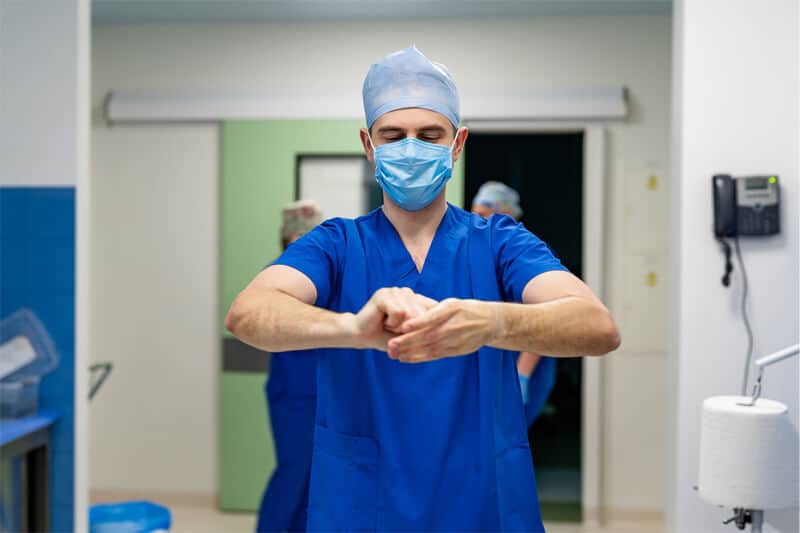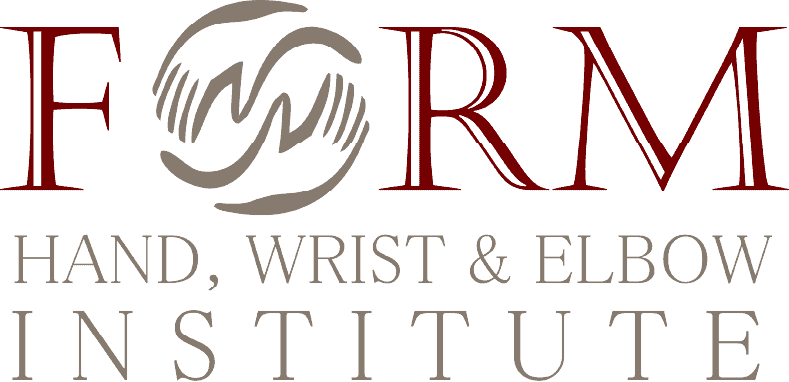Surgery Overview

Thank you for choosing FORM Hand, Wrist & Elbow for your upcoming surgical procedure. We take pride in providing the highest quality care in a safe environment. At FORM Hand, Wrist & Elbow, you will always be treated with compassion and concern for your well-being.
Please use this guide to familiarize yourself with the process. This guide will provide information on how to prepare for your surgery, what to expect, and how to plan for your care after surgery.
We understand that undergoing a surgical procedure can be stressful. Our team will talk to you about the type of surgery you are having and answer any questions you might have. We hope this guide will be useful to you.
Preoperative Instructions
Night Before Surgery
- No food or fluid after midnight the night before surgery, except for a sip of water to take your anti-inflammatory medication as directed under “Medications.”
- Arrange for a friend or family member to bring you and pick you up from surgery. Also, arrange for a responsible adult to stay with you for at least 4 hours after surgery.
- The day before surgery the nurses will give you a call to go over your medical history, current medications, as well as give you an arrival time to check-in at the surgery center. That time is usually 1.5 hours (90 minutes) prior to your scheduled procedure. It may be as early as 5:45 am. Surgery times may change due to unforeseen events. We will keep you informed if there are unexpected delays.
- If you do not follow these guidelines, your surgery may be canceled. If there are necessary exceptions to these instructions, a nurse or the doctor from the surgery center will discuss them with you.
- If you smoke, you are advised to refrain from smoking the day before surgery.
On The Day of Surgery
- Please wear comfortable clothing, flat shoes, or slippers.
- Please bring a form of ID along with your insurance card.
- Leave your valuables at home.
- If you wear contacts, please remove them prior to surgery, and please bring your glasses.
- If your child is undergoing surgery, please bring their blanket or toy. Also, please bring an approved car seat.
Post-Operative Appointments
- The first post-operative appointment will be 5-7 days after surgery. We will remove the bandages and check the wound site. You can wash with soap and water; keep the wound site clean and dry. You will either begin Hand Therapy, have a splint made (depending on the type of surgery), or be given a Home Exercise Program (HEP) at the first therapy appointment.
- The 2nd post-operative appointment will be 10-14 days after surgery. We will remove the stitches at this time.
Medications
- Anti-Inflammatory Medications (e.g., Relafen, Lodine, Motrin, Mobic, Celebrex, etc.)
- Take one (1) pill the morning of surgery with a sip of water. Then one pill twice a day (one pill after breakfast and one pill after dinner with food) beginning the evening of your surgery.
- Pain Medication (e.g., Norco, Percocet, etc.)
- Take one (1) pill every 4-6 hours for pain as needed. Please drink lots of water while taking your pain medications.
Types of Anesthesia
Anesthesiologists use a wide variety of drugs, in multiple combinations, in order to ensure that patients remain comfortable, relaxed, and free of pain during surgery or other procedures. Drugs administered by anesthesiologists are categorized as follows:
- Local anesthetics. Blocks transmission of nerve impulses without causing unconsciousness.
- General anesthetics. Brings about a state of unconsciousness.
- Analgesics. Relieves pain before, during, or after surgery.
- Sedatives. Brings about relaxation/calmness in a patient and reduces anxiety; induces sleep at higher doses.
- Muscle Relaxants. Works to paralyze skeletal muscles in order to facilitate intubation or surgery.
While only certified anesthesiologists can administer certain types of anesthesia, such as general, epidurals, and spinals, some physicians/surgeons can apply local anesthetics without the presence of an anesthesiologist.
General Anesthesia
General anesthesia places the entire body, including the brain, into a state of unconsciousness (sleep) during which the patient has no awareness and feels nothing, and will remember nothing of the surgical experience. General anesthesia is administered by injection or through a breathing mask, or sometimes both. In order to control your breathing, patients are intubated, which is the insertion of a flexible tube down the windpipe. The tube is inserted after the anesthesia is given and removed as you are waking up and breathing adequately. Upon awakening from anesthesia, patients may experience disorientation and/or a mild sore throat from the intubation.
Laryngeal Mask Airway (LMA) – When possible, the anesthesiologist will use a Laryngeal Mask Airway device instead of intubation because it is quicker and causes less discomfort for the patient. An LMA is a tube with an inflatable cuff that is inserted into the pharynx (the upper part of the windpipe).
Regional (or Local) Anesthesia
Regional anesthesia is the injection of a local anesthetic around major nerves or the spinal cord to block the pain from a large region of the body, such as a limb. Regional anesthesia provides muscle relaxation as well as postoperative pain relief since its numbing effects can last 8 to 12 hours, depending upon the dose. This reduces the need for pain medicine after surgery, as well as other side effects of surgery, such as nausea. If necessary, you may also be given a mild sedative to help you relax or sleep during surgery.
Types of Regional Anesthesia
- Axillary Nerve Block. A local anesthetic is injected around the nerve that passes through the axilla (armpit) from the shoulder to the arm to numb the feeling in your arm and hand. Typically used for surgery of the elbow, forearm, wrist, or hand.
- Bier Block. A local anesthetic is injected intravenously to numb a limb, typically the arm, and then a tourniquet is applied to prevent the anesthetic from leaving the area. Typically used on surgeries of hand or arm that last less than an hour.
MAC (Monitored Anesthesia Care)
Monitored Anesthesia Care (MAC) is the intravenous administration of mild sedatives to help a patient relax and relieve anxiety during minor procedures that do not require general anesthesia. These procedures, such as biopsies and colonoscopies, typically require the injection of a local anesthetic to numb the surgical site.
Dealing With One Hand
It’s tricky, but not impossible to get on with your life even with one hand. Here are a few suggestions which may be helpful whether you are recovering from a hand problem or anticipating surgery on your hand. Although some of these points are an issue only if your writing hand is affected, most apply to problems involving either hand. Most situations can be managed without the need for special-order adaptive devices.
Before surgery, if you can,
- Ask for help. Enlist others ahead of time to help with
- Child care
- Housework
- Meals
- Practice
- Dressing
- Undressing
- Using the toilet
- Brushing your teeth
- Showering
- Prepare for the first few days after surgery
- Open and re-seal cans and bottles you might need.
- Open medication containers and leave easy to reopen. Then, put these medication containers out of the reach of children, even if you don’t expect children to visit.
- “No-cut” meals – sandwiches, ground meats, etc.
It helps to have…
- In the shower
- Plastic bags and rubber bands to cover bandages – the bags that newspapers come in are good to cover the hand and wrist. Otherwise small trash can liners will do. Use two at a time.
- Bottle sponge (soft sponge on a long stick) – for the armpit of your “good” hand.
- Shower brush.
- A hairbrush in the shower will help you to wash your hair.
- Cotton terry cloth bathrobe – to dry your back.
- In the bathroom
- Toothpaste, shampoo, etc. in flip-top or pump (not screw top) dispensers.
- Consider an electric razor.
- Flossers (dental floss on a “Y” shaped handle).
- In the kitchen
- Dycem mat (rubber jar opener mat) – to help open jars, but also keep things from sliding around while you are working on them.
- Double suction cup pads (“little Octopus”) – to hold items while you use or wash them.
- Electric can opener with a lid magnet strong enough to hold the can in the air – for one-handed use.
- In the bedroom
- Back scratcher.
- Large sleeve shirts and tops.
- Put away clothing that buttons, fastens or snaps in the back or that uses drawstrings.
- Sports bra or a camisole instead of a bra.
- L’eggs Sheer Energy nylons can be pulled on one-handed – most others can’t.
- A “wash and wear” haircut
Surgery FAQs
The surgery start time will be determined by 3:00 pm the day before your procedure. Keep in mind that the scheduled time can be changed due to unforeseen circumstances. You may also be called the morning of surgery and asked to come in earlier, so please keep the day free and be available.
The decision about anesthesia to be used is made between you and the anesthesiologist along with your orthopedic surgeon’s recommendation.
You should be able to drive again within 1 to 2 weeks after surgery, but this typically differs from patient to patient. You should NEVER drive while taking narcotics.
After surgery, you can expect to be off from work for approximately 2 weeks. You will then be given appropriate modifications until you are finally released to full duty.
Please contact our billing department for any questions. They can be reached at (510) 505-1090.

